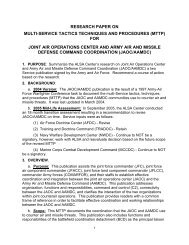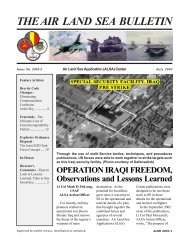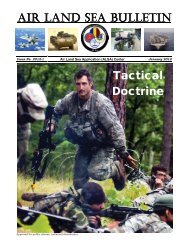AIR LAND SEA BULLETIN Attack the Network - ALSA
AIR LAND SEA BULLETIN Attack the Network - ALSA
AIR LAND SEA BULLETIN Attack the Network - ALSA
Create successful ePaper yourself
Turn your PDF publications into a flip-book with our unique Google optimized e-Paper software.
… ―restraint in<br />
<strong>the</strong> use of overwhelming<br />
power<br />
had a more profound<br />
influence<br />
on <strong>the</strong> population.‖<br />
dynamic towards achieving a political<br />
goal, in support of Clausewitz’s<br />
definition of war as an extension of<br />
politics by o<strong>the</strong>r means. Although<br />
insurgencies may also be an extension<br />
of politics, it is naturally employed<br />
by adversaries for social,<br />
cultural, and religious reasons as<br />
well. 7 COIN demands improving and<br />
developing <strong>the</strong> conditions of change<br />
to effectively mitigate <strong>the</strong> insurgents’<br />
social, cultural, or religious influences<br />
over <strong>the</strong> population. This<br />
aspect of COIN indicates slow and<br />
deliberate resourcing for populationbased<br />
actions, hence, <strong>the</strong> challengeand-response<br />
dynamic in <strong>the</strong><br />
Western way of war is <strong>the</strong> wrong<br />
approach when conducting COIN.<br />
A population-based action<br />
identifies <strong>the</strong> grievances and needs of<br />
<strong>the</strong> people, addresses those concerns,<br />
and elicits support of <strong>the</strong><br />
people towards coalition and against<br />
enemy forces. The actions taken by<br />
General John J. Pershing during <strong>the</strong><br />
Philippine Insurrection (1899-1902)<br />
demonstrated three critical principles<br />
in combating insurgency:<br />
restraint, perseverance, and <strong>the</strong><br />
objective. 8 The application of force<br />
should never be restricted in COIN.<br />
Force should be deliberate but restrained.<br />
According to David Smy<strong>the</strong>,<br />
―restraint in <strong>the</strong> use of overwhelming<br />
power had a more profound influence<br />
on <strong>the</strong> population.‖ 9 Plunk<br />
Mammoser, et. al., stated ―perseverance<br />
is <strong>the</strong> way to develop <strong>the</strong> local<br />
connections and relationships necessary<br />
to influence <strong>the</strong> population and<br />
to achieve information superiority‖.<br />
The commander should focus <strong>the</strong> fire<br />
or effect in fulfillment of <strong>the</strong> objectives<br />
instead of being an end by<br />
itself. Given time, this tactic will neutralize<br />
support for <strong>the</strong> enemy and aid<br />
in winning <strong>the</strong> strategic war. If US<br />
forces are more proactive in seeking<br />
and addressing concerns of <strong>the</strong><br />
population, US national objectives<br />
will be met sooner.<br />
The US needs fewer resources<br />
in Afghanistan to be more effective.<br />
ALSB 2012-2 24<br />
For COIN warfare, ―less is more.‖ A<br />
fighting force can often obtain more<br />
desired effects with fewer resources<br />
because having too many resources<br />
can interfere with efficiency. A<br />
greater number of resources (units<br />
and assets) can take away effectiveness<br />
by making operations cumbersome,<br />
diluting messages through<br />
multiple variations of <strong>the</strong> messages,<br />
decreasing mobility, and causing<br />
competition for key assets and<br />
equipment. Just because <strong>the</strong> US has<br />
<strong>the</strong> ability to mobilize large amounts<br />
of resources and finances to wage<br />
war does not mean that <strong>the</strong> US<br />
should. For example, a few special<br />
forces and military information support<br />
operations teams could have a<br />
greater impact on <strong>the</strong> COIN fight<br />
because influencing populations is<br />
<strong>the</strong>ir expertise. Also, conventional<br />
forces are bulky and expensive. They<br />
can hinder effective processes with<br />
restrictive rules of engagement and<br />
an overly-aggressive posture. Commanders<br />
need greater control to<br />
maintain order over larger numbers<br />
of forces. Additional control equates<br />
to additional rules that can restrict<br />
effectiveness.<br />
There are two more negative<br />
aspects to <strong>the</strong> excessive mobilization<br />
of resources. First, surging equipment<br />
and personnel to <strong>the</strong> battlefield<br />
may help win <strong>the</strong> fight at <strong>the</strong> tactical<br />
or operational level of war, but may<br />
result in <strong>the</strong> US losing <strong>the</strong> strategic<br />
victory. The center of gravity in<br />
COIN—<strong>the</strong> one thing that is essential<br />
to ultimate victory—is winning <strong>the</strong><br />
―hearts and minds‖ of <strong>the</strong> people.<br />
Massive amounts of equipment and<br />
personnel are usually perceived by a<br />
local population as occupation by a<br />
foreign nation. Occupation is always<br />
perceived negatively. Second, <strong>the</strong> US<br />
must consider its return on<br />
investment. Deploying more troops<br />
and equipment costs more money. If<br />
<strong>the</strong> US and allies can accomplish <strong>the</strong><br />
mission at a lower cost <strong>the</strong>y should<br />
do so.





